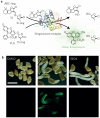Plant synthetic biology for molecular engineering of signalling and development
- PMID: 27249346
- PMCID: PMC5164986
- DOI: 10.1038/nplants.2016.10
Plant synthetic biology for molecular engineering of signalling and development
Abstract
Molecular genetic studies of model plants in the past few decades have identified many key genes and pathways controlling development, metabolism and environmental responses. Recent technological and informatics advances have led to unprecedented volumes of data that may uncover underlying principles of plants as biological systems. The newly emerged discipline of synthetic biology and related molecular engineering approaches is built on this strong foundation. Today, plant regulatory pathways can be reconstituted in heterologous organisms to identify and manipulate parameters influencing signalling outputs. Moreover, regulatory circuits that include receptors, ligands, signal transduction components, epigenetic machinery and molecular motors can be engineered and introduced into plants to create novel traits in a predictive manner. Here, we provide a brief history of plant synthetic biology and significant recent examples of this approach, focusing on how knowledge generated by the reference plant Arabidopsis thaliana has contributed to the rapid rise of this new discipline, and discuss potential future directions.
Figures




Similar articles
-
Plant and bacterial systems biology as platform for plant synthetic bio(techno)logy.J Biotechnol. 2012 Jul 31;160(1-2):80-90. doi: 10.1016/j.jbiotec.2012.01.014. Epub 2012 Jan 25. J Biotechnol. 2012. PMID: 22306308 Review.
-
Quantitative characterization of genetic parts and circuits for plant synthetic biology.Nat Methods. 2016 Jan;13(1):94-100. doi: 10.1038/nmeth.3659. Epub 2015 Nov 16. Nat Methods. 2016. PMID: 26569598
-
Arabidopsis: the original plant chassis organism.Plant Cell Rep. 2018 Oct;37(10):1359-1366. doi: 10.1007/s00299-018-2286-5. Epub 2018 Apr 16. Plant Cell Rep. 2018. PMID: 29663032 Review.
-
Synthetic strategies for plant signalling studies: molecular toolbox and orthogonal platforms.Plant J. 2016 Jul;87(1):118-38. doi: 10.1111/tpj.13218. Plant J. 2016. PMID: 27227549 Review.
-
Plant synthetic biology.Trends Plant Sci. 2015 May;20(5):309-317. doi: 10.1016/j.tplants.2015.02.004. Epub 2015 Mar 27. Trends Plant Sci. 2015. PMID: 25825364 Review.
Cited by
-
The Multiplanetary Future of Plant Synthetic Biology.Genes (Basel). 2018 Jul 10;9(7):348. doi: 10.3390/genes9070348. Genes (Basel). 2018. PMID: 29996548 Free PMC article.
-
A century of studying plant secondary metabolism-From "what?" to "where, how, and why?".Plant Physiol. 2024 Apr 30;195(1):48-66. doi: 10.1093/plphys/kiad596. Plant Physiol. 2024. PMID: 38163637 Free PMC article. Review.
-
Synthetic Biology in Plants, a Boon for Coming Decades.Mol Biotechnol. 2021 Dec;63(12):1138-1154. doi: 10.1007/s12033-021-00386-9. Epub 2021 Aug 21. Mol Biotechnol. 2021. PMID: 34420149 Review.
-
ABA Accumulation in Dehydrating Leaves Is Associated with Decline in Cell Volume, Not Turgor Pressure.Plant Physiol. 2018 Jan;176(1):489-495. doi: 10.1104/pp.17.01097. Epub 2017 Oct 23. Plant Physiol. 2018. PMID: 29061906 Free PMC article.
-
Plant Chemical Genetics: From Phenotype-Based Screens to Synthetic Biology.Plant Physiol. 2017 May;174(1):5-20. doi: 10.1104/pp.16.01805. Epub 2017 Mar 8. Plant Physiol. 2017. PMID: 28275150 Free PMC article. Review.
References
-
- The Arabidopsis Genome Initiative Analysis of the genome sequence of the flowering plant Arabidopsis thaliana. Nature. 2000;408:796–815. - PubMed
-
- Medford JI, Prasad A. Plant synthetic biology takes root. Science. 2014;346:162–163. - PubMed
-
- Purnick PE, Weiss R. The second wave of synthetic biology: from modules to systems. Nature Rev. Mol. Cell Biol. 2009;10:410–422. - PubMed
Publication types
MeSH terms
Grants and funding
LinkOut - more resources
Full Text Sources
Other Literature Sources
Miscellaneous

